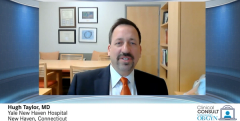
Overview of Endometriosis
Hugh Taylor, MD, differentiates endometriosis from other disorders causing pelvic pain and shares common risk factors for the disease.
Episodes in this series

Hugh Taylor, MD: Hello. Welcome to this Contemporary OB/GYNÒ Clinical Consult titled, “Updates in The Management of Endometriosis.” I’m Dr Hugh Taylor, professor and chair of the department of obstetrics, gynecology, and reproductive sciences at the Yale School of Medicine, and chief of obstetrics and gynecology at the Yale New Haven Hospital [New Haven, Connecticut]. Our discussion today will focus on endometriosis and the various factors that shape our treatment approaches to the disease. We’ll look at diagnostic tools for endometriosis, treatment options, as well as gaps in care.
It’s important that we differentiate endometriosis from other disorders that can cause pelvic pain. Endometriosis is by far the most common cause of pelvic pain in women in the reproductive age range. So it’s very likely that a woman presenting with pelvic pain has endometriosis, but we need to rule out other etiologies, that may be cysts, adenomyosis, infectious etiologies, tumors, musculoskeletal problems. There’s a whole host of other things. Our job when somebody comes in with pelvic pain is to start to think about what signs and symptoms may make it more likely to be endometriosis and rule out other potential causes of pelvic pain.
In general, endometriosis typically presents initially as dysmenorrhea. Often menarche will occur, someone will have some time with periods that are not extremely painful. These will progress to dysmenorrhea, and the pain may over time go beyond dysmenorrhea. There may be pelvic pain outside of the time of menses. There may be pelvic pain that is not specifically menstrual uterine cramps. We have to assume that some of these other pains may very well be due to endometriosis. Endometriosis typically starts with cyclic pelvic pain, typically dysmenorrhea. Endometriosis is also often a progressive disease. It may start out with dysmenorrhea that gets worse over time and then gradually go beyond the time of menses, gradually occur in other areas of the pelvis or abdomen and start to affect other organ systems. Most women with progressive cyclic pain have endometriosis. I think that’s the hallmark of the disease, that it is cyclic. If the pain is not cyclic, does not occur with menses initially, occurs randomly throughout the menstrual cycle or continuously, that’s probably not endometriosis, and start looking for other causes of the pain. If someone has extremely painful menses from the very first period at menarche, and they don’t progress or get worse, that may not be endometriosis. So I look for cyclic progressive pain, most of those women will have endometriosis.
The risk factors associated with endometriosis typically are those that would increase menstrual flow and exposure to menstrual flow. Remember, endometriosis is caused predominantly by retrograde menstruation. The menstrual flow goes backward out the fallopian tubes and into the peritoneal cavity where some of those cells implant and continue to grow. Everyone has a bit of retrograde menstruation, and we don’t know why in some circumstances that continues to persist as endometriosis, but we do know that the more retrograde menstruation someone has, the more likely they are to have endometriosis. Particularly with heavy periods, in addition to the antegrade flow, the normal period, there is probably more retrograde flow as well. Early menarche, more exposure to more periods, also is a risk factor. Things like use of birth control pills that reduce menstrual flow are protective. So not using contraceptives, not being pregnant, the more menses and the heavier the menses you have during your life, tend to be risk factors for endometriosis. One of the other huge risk factors though is family history. There is a genetic component, and probably about half the risk of endometriosis is due to that genetic component. There’s certainly an environmental component and other etiologies of endometriosis, but there is certainly a genetic component. A family history of endometriosis is a very strong risk factor.
Transcript Edited for Clarity
Newsletter
Get the latest clinical updates, case studies, and expert commentary in obstetric and gynecologic care. Sign up now to stay informed.











